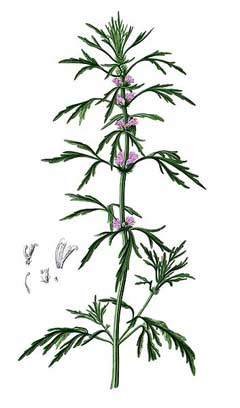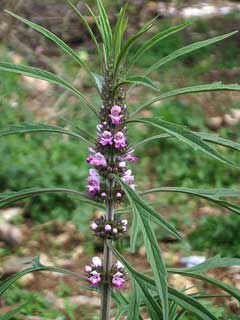 |
|
http://commons.wikimedia.org/wiki/File:Leonurus_japonicus_Blanco2.259-cropped.jpg |
 |
| http://commons.wikimedia.org/wiki/User:Tau%CA%BBolunga |
Translate this page:
Summary
Physical Characteristics

 Leonurus japonicus is a ANNUAL/BIENNIAL growing to 0.9 m (3ft). It is in flower from July to September, and the seeds ripen from August to September. The species is hermaphrodite (has both male and female organs) and is pollinated by Bees.
Leonurus japonicus is a ANNUAL/BIENNIAL growing to 0.9 m (3ft). It is in flower from July to September, and the seeds ripen from August to September. The species is hermaphrodite (has both male and female organs) and is pollinated by Bees.
Suitable for: light (sandy), medium (loamy) and heavy (clay) soils and can grow in nutritionally poor soil. Suitable pH: mildly acid, neutral and basic (mildly alkaline) soils. It can grow in semi-shade (light woodland) or no shade. It prefers moist soil.
UK Hardiness Map
US Hardiness Map
Synonyms
Plant Habitats
Cultivated Beds;
Edible Uses
References More on Edible Uses
Medicinal Uses
Plants For A Future can not take any responsibility for any adverse effects from the use of plants. Always seek advice from a professional before using a plant medicinally.
Alterative Antibacterial Antifungal Aphrodisiac Birthing aid Contraceptive Depurative Diuretic
Eczema Emmenagogue Hypotensive Ophthalmic Poultice Vasodilator Vulnerary
Women's complaints
This plant (and other closely related species) is commonly used in Chinese herbalism, where it is considered to be one of the 50 fundamental herbs[218]. The leaves are diuretic and are placed in bath water to relieve itching and painful shingles[218]. The dried flowers are emmenagogue and are also used in pregnancy and to help expel the placenta after giving birth[218]. The juice of the stems is vulnerary[218]. The fruit is antibacterial, diuretic, emmenagogue, hypotensive, ophthalmic and vasodilator[176, 218]. It is used in the treatment of abnormal menstruation, nebula and conjunctivitis[176]. The seed is aphrodisiac, diuretic, emmenagogue, ophthalmic and is also used in the treatment of various women's complaints[147, 218]. The plant was ranked number one in a survey of 250 potential antifertility plants in China[218]. The seed is used in the treatment of conjunctivitis and night blindness[147]. The aerial parts of the plant are alterative, antibacterial, antifungal, depurative, diuretic, emmenagogue, hypotensive, vasodilator and vulnerary[176, 218]. The whole plant is decocted, either on its own or with other herbs, as an ophthalmic[218]. It is used in the treatment of abnormal menstruation, postpartum abdominal pain, tumours, uterine bleeding, oedema, eczema and purulent abscess[176]. It is also used externally as a poultice for bruises[218]. Stimulates blood circulation[147]. (The part of the plant used is not made clear.)
References More on Medicinal Uses
The Bookshop: Edible Plant Books
Our Latest books on Perennial Plants For Food Forests and Permaculture Gardens in paperback or digital formats.

Edible Tropical Plants
Food Forest Plants for Hotter Conditions: 250+ Plants For Tropical Food Forests & Permaculture Gardens.
More

Edible Temperate Plants
Plants for Your Food Forest: 500 Plants for Temperate Food Forests & Permaculture Gardens.
More

More Books
PFAF have eight books available in paperback and digital formats. Browse the shop for more information.
Shop Now
Other Uses
References More on Other Uses
Cultivation details
We have almost no information on this species and do not know if it will be hardy in this country. The following notes are based on the general needs of the genus. Succeeds in most soils[200]. Prefers a poor soil[108]. There is some doubt over the correct name for this species, a recent work suggested that it should be L. artemisia (Lour.)S.Y.Hu. - at least in as much as it refers to the medicinal plant in China[218].
References Carbon Farming Information and Carbon Sequestration Information
Temperature Converter
Type a value in the Celsius field to convert the value to Fahrenheit:
Fahrenheit:
The PFAF Bookshop
Plants For A Future have a number of books available in paperback and digital form. Book titles include Edible Plants, Edible Perennials, Edible Trees,Edible Shrubs, Woodland Gardening, and Temperate Food Forest Plants. Our new book is Food Forest Plants For Hotter Conditions (Tropical and Sub-Tropical).
Shop Now
Plant Propagation
Seed - sow spring in a cold frame. When they are large enough to handle, prick the seedlings out into individual pots and plant them out in the summer.
Other Names
If available other names are mentioned here
Native Range
TEMPERATE ASIA: Russian Federation (Primorye, Amur), China, Korea TROPICAL ASIA: India (north), Nepal, Cambodia, Laos, Myanmar, Thailand, Vietnam, Malaysia (Malaya)
Weed Potential
Right plant wrong place. We are currently updating this section.
Please note that a plant may be invasive in one area but may not in your area so it's worth checking.
Conservation Status
IUCN Red List of Threatened Plants Status :

Growth: S = slow M = medium F = fast. Soil: L = light (sandy) M = medium H = heavy (clay). pH: A = acid N = neutral B = basic (alkaline). Shade: F = full shade S = semi-shade N = no shade. Moisture: D = dry M = Moist We = wet Wa = water.
Now available:
Food Forest Plants for Mediterranean Conditions
350+ Perennial Plants For Mediterranean and Drier Food Forests and Permaculture Gardens.
[Paperback and eBook]
This is the third in Plants For A Future's series of plant guides for food forests tailored to
specific climate zones. Following volumes on temperate and tropical ecosystems, this book focuses
on species suited to Mediterranean conditions—regions with hot, dry summers and cool, wet winters,
often facing the added challenge of climate change.
Read More
Expert comment
Author
Houtt.
Botanical References
266
Links / References
For a list of references used on this page please go here
Readers comment
| Add a comment |
|
If you have important information about this plant that may help other users please add a comment or link below. Only comments or links that are felt to be directly relevant to a plant will be included. If you think a comment/link or information contained on this page is inaccurate or misleading we would welcome your feedback at [email protected]. If you have questions about a plant please use the Forum on this website as we do not have the resources to answer questions ourselves.
* Please note: the comments by website users are not necessarily those held by PFAF and may give misleading or inaccurate information.
To leave a comment please Register or login here All comments need to be approved so will not appear immediately.
|
Subject : Leonurus japonicus
|
|
|
|